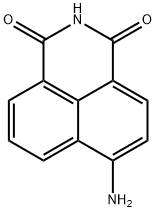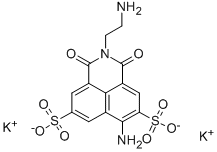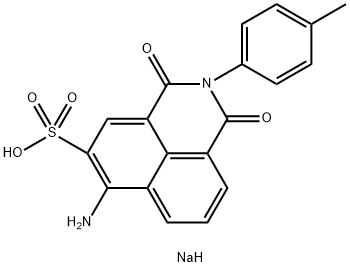4-AMINO-1,8-NAPHTHALIMIDE
- CAS NO.:1742-95-6
- Empirical Formula: C12H8N2O2
- Molecular Weight: 212.2
- MDL number: MFCD00006921
- EINECS: 217-110-1
- SAFETY DATA SHEET (SDS)
- Update Date: 2024-11-19 20:33:22

What is 4-AMINO-1,8-NAPHTHALIMIDE?
Description
The poly(ADP-ribose) polymerases (PARPs) form a family of enzymes with roles in DNA repair and apoptosis, particularly in response to reactive oxygen and nitrogen species. 4-amino-1,8-Naphthalimide (4-ANI) is an inhibitor of PARP (IC50 = 180 nM). It blocks radiation-induced PARP in cancer cells, potentiating the cytotoxicity of γ-radiation, although it is not cytotoxic in the absence of radiation. 4-ANI is used to study the role of PARP activity in various cell systems.
Chemical properties
orange amorphous powder
The Uses of 4-AMINO-1,8-NAPHTHALIMIDE
The poly(ADP-ribose) polymerases (PARPs) form a family of enzymes with roles in DNA repair and apoptosis, particularly in response to reactive oxygen and nitrogen species. 4-amino-1,8-Naphthalimide (4-ANI) is an inhibitor of PARP (IC50 = 180 nM). It blocks radiation-induced PARP in cancer cells, potentiating the cytotoxicity of γ-radiation, although it is not cytotoxic in the absence of radiation. 4-ANI is used to study the role of PARP activity in various cell systems.
What are the applications of Application
4-Amino-1,8-naphthalimide is a PARP-1 inhibitor
Definition
ChEBI: 4-amino-1,8-naphthalimide is a benzoisoquinoline and a dicarboximide.
Biochem/physiol Actions
4-Amino-1,8-naphthalimide sensitizes cells to radiation-induced cell damage and enhances the cytotoxicity of 1-methyl-3-nitro-1-nitrosoguanidine.
Enzyme inhibitor
This PARP inhibitor (FW = 212.21 g/mol) is a strong inhibitor of NAD:ADP-ribosyltransferase or poly(ADP-ribose) polymerase (IC50 = 0.18 μM). In addition, 4-Amino-1,8-naphthalimide is a radiation sensitizer at non-toxic and low concentrations.
References
[1]. schlicker a, peschke p, bürkle a, et al. 4-amino-1,8-naphthalimide: a novel inhibitor of poly(adp-ribose) polymerase and radiation sensitizer. int j radiat biol. 1999 jan;75(1):91-100.
[2]. davar d1, beumer jh, hamieh l, et al. role of parp inhibitors in cancer biology and therapy. curr med chem. 2012;19(23):3907-21.
[3]. banasik m, komura h, shimoyama m,et al. specific inhibitors of poly(adp-ribose) synthetase and mono(adp-ribosyl)transferase. j biol chem. 1992 jan 25;267(3):1569-75.
[4]. issaeva n, thomas hd, djureinovic t, et al. 6-thioguanine selectively kills brca2-defective tumors and overcomes parp inhibitor resistance. cancer res. 2010 aug 1;70(15):6268-76.
Properties of 4-AMINO-1,8-NAPHTHALIMIDE
| Melting point: | 360 °C |
| Boiling point: | 352.04°C (rough estimate) |
| Density | 1.105 g/mL at 25 °C(lit.) |
| vapor pressure | 0Pa at 25℃ |
| refractive index | 1.6000 (estimate) |
| storage temp. | -20°C |
| solubility | Soluble in DMSO |
| form | Orange solid. |
| pka | 9.53±0.20(Predicted) |
| color | Yellow to brown |
| Water Solubility | 354mg/L at 25℃ |
| CAS DataBase Reference | 1742-95-6 |
| EPA Substance Registry System | 1H-Benz[de]isoquinoline-1,3(2H)-dione, 6-amino- (1742-95-6) |
Safety information for 4-AMINO-1,8-NAPHTHALIMIDE
| Signal word | Warning |
| Pictogram(s) |
 Exclamation Mark Irritant GHS07 |
| GHS Hazard Statements |
H315:Skin corrosion/irritation H319:Serious eye damage/eye irritation H335:Specific target organ toxicity, single exposure;Respiratory tract irritation |
| Precautionary Statement Codes |
P261:Avoid breathing dust/fume/gas/mist/vapours/spray. P264:Wash hands thoroughly after handling. P264:Wash skin thouroughly after handling. P271:Use only outdoors or in a well-ventilated area. P280:Wear protective gloves/protective clothing/eye protection/face protection. P302+P352:IF ON SKIN: wash with plenty of soap and water. P305+P351+P338:IF IN EYES: Rinse cautiously with water for several minutes. Remove contact lenses, if present and easy to do. Continuerinsing. |
Computed Descriptors for 4-AMINO-1,8-NAPHTHALIMIDE
New Products
4-AMINO-TETRAHYDRO-PYRAN-4-CARBOXYLIC ACID HCL 4-(Dimethylamino)tetrahydro-2H-pyran-4-carbonitrile 4-Aminotetrahydropyran-4-carbonitrile Hydrochloride (R)-3-Aminobutanenitrile Hydrochloride 3-((Dimethylamino)methyl)-5-methylhexan-2-one oxalate 1,4-Dioxa-8-azaspiro[4.5]decane 5-Bromo-2-nitropyridine Nimesulide BP Aceclofenac IP/BP/EP Diclofenac Sodium IP/BP/EP/USP Mefenamic Acid IP/BP/EP/USP Ornidazole IP Diclofenac Potassium THOMAIND PAPER PH 2.0 TO 4.5 1 BOX BUFFER CAPSULE PH 9.2 - 10 CAP SODIUM CHLORIDE 0.1N CVS ALLOXAN MONOHYDRATE 98% PLATINUM 0.5% ON 3 MM ALUMINA PELLETS (TYPE 73) LITHIUM AAS SOLUTION 2-Bromo-1-(bromomethyl)-3-chloro-5-nitrobenzene 2-Bromo-3-nitroaniline N-(3-Hydroxypropyl)-N-methylacetamide 3-Bromo-6-chloropyridazine 4-ethyl-3-nitrobenzoic acidRelated products of tetrahydrofuran



![2-AMINO-6-NITRO-BENZO[DE]ISOQUINOLINE-1,3-DIONE](https://img.chemicalbook.in/StructureFile/ChemBookStructure2/GIF/CB4477554.gif)

![2-(6-NITRO-1,3-DIOXO-1H-BENZO[DE]ISOQUINOLIN-2(3H)-YL)BENZOIC ACID](https://img.chemicalbook.in/StructureFile/ChemBookStructure3/GIF/CB7330919.gif)
![2-BENZYL-6-PYRROLIDIN-1-YL-1H-BENZO[DE]ISOQUINOLINE-1,3(2H)-DIONE](https://img.chemicalbook.in/StructureFile/ChemBookStructure5/GIF/CB1121599.gif)
![2-(4-AMINOPHENYL)-6-NITRO-1H-BENZO[DE]ISOQUINOLINE-1,3(2H)-DIONE](https://img.chemicalbook.in/StructureFile/ChemBookStructure7/GIF/CB4676924.gif)
You may like
-
 4-Amino-1,8-naphthalimide CAS 1742-95-6View Details
4-Amino-1,8-naphthalimide CAS 1742-95-6View Details
1742-95-6 -
 1-Methyl-6-oxo-1,6-dihydropyridazine-3-carbonitrile 98%View Details
1-Methyl-6-oxo-1,6-dihydropyridazine-3-carbonitrile 98%View Details
99903-60-3 -
 1823368-42-8 98%View Details
1823368-42-8 98%View Details
1823368-42-8 -
 2-(3-(tert-butyl)phenoxy)-2-methylpropanoic acid 1307449-08-6 98%View Details
2-(3-(tert-butyl)phenoxy)-2-methylpropanoic acid 1307449-08-6 98%View Details
1307449-08-6 -
 Ethyl 3-(furan-2-yl)-3-hydroxypropanoate 25408-95-1 98%View Details
Ethyl 3-(furan-2-yl)-3-hydroxypropanoate 25408-95-1 98%View Details
25408-95-1 -
 2-Chloro-5-fluoro-1-methoxy-3-methylbenzene 98%View Details
2-Chloro-5-fluoro-1-methoxy-3-methylbenzene 98%View Details
1805639-70-6 -
 1784294-80-9 98%View Details
1784294-80-9 98%View Details
1784294-80-9 -
 Lithium ClavulanateView Details
Lithium ClavulanateView Details
61177-44-4